Kuang-Da Wang
Mixture Experts with Test-Time Self-Supervised Aggregation for Tabular Imbalanced Regression
Jun 08, 2025



Abstract:Tabular data serve as a fundamental and ubiquitous representation of structured information in numerous real-world applications, e.g., finance and urban planning. In the realm of tabular imbalanced applications, data imbalance has been investigated in classification tasks with insufficient instances in certain labels, causing the model's ineffective generalizability. However, the imbalance issue of tabular regression tasks is underexplored, and yet is critical due to unclear boundaries for continuous labels and simplifying assumptions in existing imbalance regression work, which often rely on known and balanced test distributions. Such assumptions may not hold in practice and can lead to performance degradation. To address these issues, we propose MATI: Mixture Experts with Test-Time Self-Supervised Aggregation for Tabular Imbalance Regression, featuring two key innovations: (i) the Region-Aware Mixture Expert, which adopts a Gaussian Mixture Model to capture the underlying related regions. The statistical information of each Gaussian component is then used to synthesize and train region-specific experts to capture the unique characteristics of their respective regions. (ii) Test-Time Self-Supervised Expert Aggregation, which dynamically adjusts region expert weights based on test data features to reinforce expert adaptation across varying test distributions. We evaluated MATI on four real-world tabular imbalance regression datasets, including house pricing, bike sharing, and age prediction. To reflect realistic deployment scenarios, we adopted three types of test distributions: a balanced distribution with uniform target frequencies, a normal distribution that follows the training data, and an inverse distribution that emphasizes rare target regions. On average across these three test distributions, MATI achieved a 7.1% improvement in MAE compared to existing methods.
Template-Based Financial Report Generation in Agentic and Decomposed Information Retrieval
Apr 19, 2025Abstract:Tailoring structured financial reports from companies' earnings releases is crucial for understanding financial performance and has been widely adopted in real-world analytics. However, existing summarization methods often generate broad, high-level summaries, which may lack the precision and detail required for financial reports that typically focus on specific, structured sections. While Large Language Models (LLMs) hold promise, generating reports adhering to predefined multi-section templates remains challenging. This paper investigates two LLM-based approaches popular in industry for generating templated financial reports: an agentic information retrieval (IR) framework and a decomposed IR approach, namely AgenticIR and DecomposedIR. The AgenticIR utilizes collaborative agents prompted with the full template. In contrast, the DecomposedIR approach applies a prompt chaining workflow to break down the template and reframe each section as a query answered by the LLM using the earnings release. To quantitatively assess the generated reports, we evaluated both methods in two scenarios: one using a financial dataset without direct human references, and another with a weather-domain dataset featuring expert-written reports. Experimental results show that while AgenticIR may excel in orchestrating tasks and generating concise reports through agent collaboration, DecomposedIR statistically significantly outperforms AgenticIR approach in providing broader and more detailed coverage in both scenarios, offering reflection on the utilization of the agentic framework in real-world applications.
Plan2Align: Predictive Planning Based Test-Time Preference Alignment in Paragraph-Level Machine Translation
Feb 28, 2025Abstract:Machine Translation (MT) has been predominantly designed for sentence-level translation using transformer-based architectures. While next-token prediction based Large Language Models (LLMs) demonstrate strong capabilities in long-text translation, non-extensive language models often suffer from omissions and semantic inconsistencies when processing paragraphs. Existing preference alignment methods improve sentence-level translation but fail to ensure coherence over extended contexts due to the myopic nature of next-token generation. We introduce Plan2Align, a test-time alignment framework that treats translation as a predictive planning problem, adapting Model Predictive Control to iteratively refine translation outputs. Experiments on WMT24 Discourse-Level Literary Translation show that Plan2Align significantly improves paragraph-level translation, achieving performance surpassing or on par with the existing training-time and test-time alignment methods on LLaMA-3.1 8B.
APAR: Modeling Irregular Target Functions in Tabular Regression via Arithmetic-Aware Pre-Training and Adaptive-Regularized Fine-Tuning
Dec 14, 2024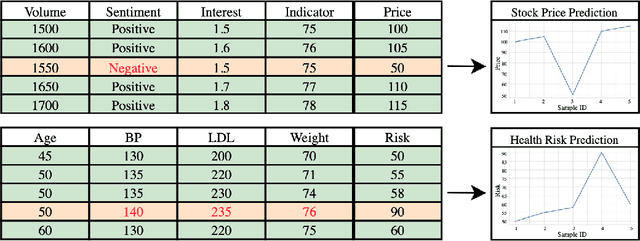
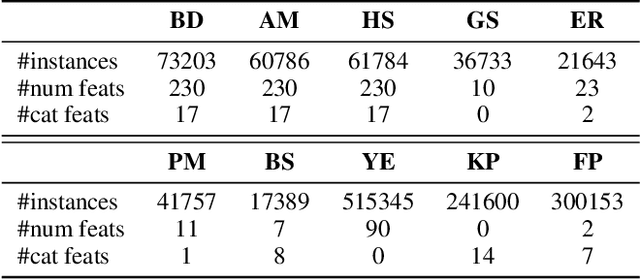


Abstract:Tabular data are fundamental in common machine learning applications, ranging from finance to genomics and healthcare. This paper focuses on tabular regression tasks, a field where deep learning (DL) methods are not consistently superior to machine learning (ML) models due to the challenges posed by irregular target functions inherent in tabular data, causing sensitive label changes with minor variations from features. To address these issues, we propose a novel Arithmetic-Aware Pre-training and Adaptive-Regularized Fine-tuning framework (APAR), which enables the model to fit irregular target function in tabular data while reducing the negative impact of overfitting. In the pre-training phase, APAR introduces an arithmetic-aware pretext objective to capture intricate sample-wise relationships from the perspective of continuous labels. In the fine-tuning phase, a consistency-based adaptive regularization technique is proposed to self-learn appropriate data augmentation. Extensive experiments across 10 datasets demonstrated that APAR outperforms existing GBDT-, supervised NN-, and pretrain-finetune NN-based methods in RMSE (+9.43% $\sim$ 20.37%), and empirically validated the effects of pre-training tasks, including the study of arithmetic operations. Our code and data are publicly available at https://github.com/johnnyhwu/APAR.
BADGE: BADminton report Generation and Evaluation with LLM
Jun 26, 2024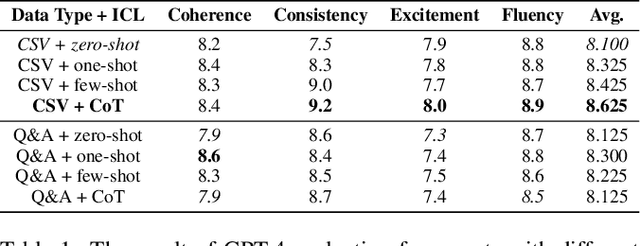


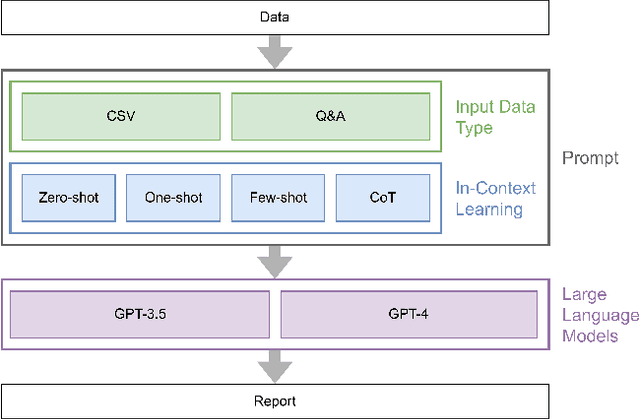
Abstract:Badminton enjoys widespread popularity, and reports on matches generally include details such as player names, game scores, and ball types, providing audiences with a comprehensive view of the games. However, writing these reports can be a time-consuming task. This challenge led us to explore whether a Large Language Model (LLM) could automate the generation and evaluation of badminton reports. We introduce a novel framework named BADGE, designed for this purpose using LLM. Our method consists of two main phases: Report Generation and Report Evaluation. Initially, badminton-related data is processed by the LLM, which then generates a detailed report of the match. We tested different Input Data Types, In-Context Learning (ICL), and LLM, finding that GPT-4 performs best when using CSV data type and the Chain of Thought prompting. Following report generation, the LLM evaluates and scores the reports to assess their quality. Our comparisons between the scores evaluated by GPT-4 and human judges show a tendency to prefer GPT-4 generated reports. Since the application of LLM in badminton reporting remains largely unexplored, our research serves as a foundational step for future advancements in this area. Moreover, our method can be extended to other sports games, thereby enhancing sports promotion. For more details, please refer to https://github.com/AndyChiangSH/BADGE.
Offline Imitation of Badminton Player Behavior via Experiential Contexts and Brownian Motion
Mar 19, 2024Abstract:In the dynamic and rapid tactic involvements of turn-based sports, badminton stands out as an intrinsic paradigm that requires alter-dependent decision-making of players. While the advancement of learning from offline expert data in sequential decision-making has been witnessed in various domains, how to rally-wise imitate the behaviors of human players from offline badminton matches has remained underexplored. Replicating opponents' behavior benefits players by allowing them to undergo strategic development with direction before matches. However, directly applying existing methods suffers from the inherent hierarchy of the match and the compounding effect due to the turn-based nature of players alternatively taking actions. In this paper, we propose RallyNet, a novel hierarchical offline imitation learning model for badminton player behaviors: (i) RallyNet captures players' decision dependencies by modeling decision-making processes as a contextual Markov decision process. (ii) RallyNet leverages the experience to generate context as the agent's intent in the rally. (iii) To generate more realistic behavior, RallyNet leverages Geometric Brownian Motion (GBM) to model the interactions between players by introducing a valuable inductive bias for learning player behaviors. In this manner, RallyNet links player intents with interaction models with GBM, providing an understanding of interactions for sports analytics. We extensively validate RallyNet with the largest available real-world badminton dataset consisting of men's and women's singles, demonstrating its ability to imitate player behaviors. Results reveal RallyNet's superiority over offline imitation learning methods and state-of-the-art turn-based approaches, outperforming them by at least 16% in mean rule-based agent normalization score. Furthermore, we discuss various practical use cases to highlight RallyNet's applicability.
Root Cause Analysis In Microservice Using Neural Granger Causal Discovery
Feb 02, 2024Abstract:In recent years, microservices have gained widespread adoption in IT operations due to their scalability, maintenance, and flexibility. However, it becomes challenging for site reliability engineers (SREs) to pinpoint the root cause due to the complex relationships in microservices when facing system malfunctions. Previous research employed structured learning methods (e.g., PC-algorithm) to establish causal relationships and derive root causes from causal graphs. Nevertheless, they ignored the temporal order of time series data and failed to leverage the rich information inherent in the temporal relationships. For instance, in cases where there is a sudden spike in CPU utilization, it can lead to an increase in latency for other microservices. However, in this scenario, the anomaly in CPU utilization occurs before the latency increase, rather than simultaneously. As a result, the PC-algorithm fails to capture such characteristics. To address these challenges, we propose RUN, a novel approach for root cause analysis using neural Granger causal discovery with contrastive learning. RUN enhances the backbone encoder by integrating contextual information from time series, and leverages a time series forecasting model to conduct neural Granger causal discovery. In addition, RUN incorporates Pagerank with a personalization vector to efficiently recommend the top-k root causes. Extensive experiments conducted on the synthetic and real-world microservice-based datasets demonstrate that RUN noticeably outperforms the state-of-the-art root cause analysis methods. Moreover, we provide an analysis scenario for the sock-shop case to showcase the practicality and efficacy of RUN in microservice-based applications. Our code is publicly available at https://github.com/zmlin1998/RUN.
NYCU-TWO at Memotion 3: Good Foundation, Good Teacher, then you have Good Meme Analysis
Feb 14, 2023Abstract:This paper presents a robust solution to the Memotion 3.0 Shared Task. The goal of this task is to classify the emotion and the corresponding intensity expressed by memes, which are usually in the form of images with short captions on social media. Understanding the multi-modal features of the given memes will be the key to solving the task. In this work, we use CLIP to extract aligned image-text features and propose a novel meme sentiment analysis framework, consisting of a Cooperative Teaching Model (CTM) for Task A and a Cascaded Emotion Classifier (CEC) for Tasks B&C. CTM is based on the idea of knowledge distillation, and can better predict the sentiment of a given meme in Task A; CEC can leverage the emotion intensity suggestion from the prediction of Task C to classify the emotion more precisely in Task B. Experiments show that we achieved the 2nd place ranking for both Task A and Task B and the 4th place ranking for Task C, with weighted F1-scores of 0.342, 0.784, and 0.535 respectively. The results show the robustness and effectiveness of our framework. Our code is released at github.
A Reinforcement Learning Badminton Environment for Simulating Player Tactics (Student Abstract)
Nov 22, 2022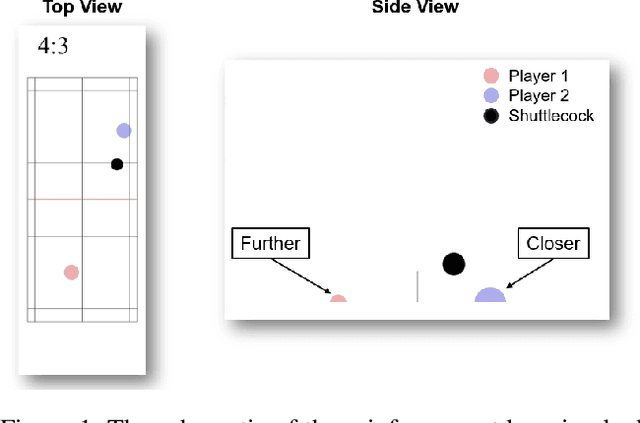
Abstract:Recent techniques for analyzing sports precisely has stimulated various approaches to improve player performance and fan engagement. However, existing approaches are only able to evaluate offline performance since testing in real-time matches requires exhaustive costs and cannot be replicated. To test in a safe and reproducible simulator, we focus on turn-based sports and introduce a badminton environment by simulating rallies with different angles of view and designing the states, actions, and training procedures. This benefits not only coaches and players by simulating past matches for tactic investigation, but also researchers from rapidly evaluating their novel algorithms.
 Add to Chrome
Add to Chrome Add to Firefox
Add to Firefox Add to Edge
Add to Edge